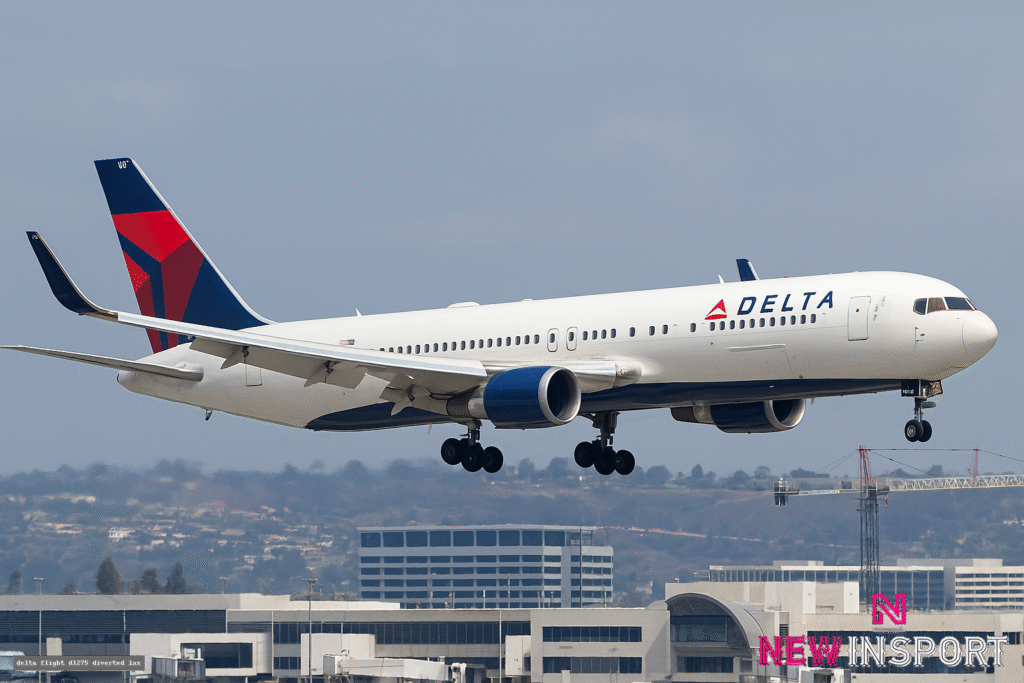Introduction
Even though air travel is mostly efficient and safe, it still may encounter sudden and unexpected issues. Among those are flight diversions, which are not only events that happen quite seldom but also the ones that attract attention worldwide. It was the same with Delta Flight DL275’s emergency landing at Los Angeles International Airport (LAX).
There was a lot more to it than just a disruption of schedules, which, in turn, made people, passengers, flight enthusiasts, and even the general public wonder a great deal about what had happened. What made the flight change its route? Were the passengers in danger? What actions did Delta Airlines take? And what can the whole aviation sector learn from it?
This detailed Article takes a deep dive into every aspect leading up to and following the unexpected offloading of DL275, providing details about the event, its causes, the feelings of passengers, what the airline did, and general safety in the air, as well as the wider pros and cons of the matter.
Background: Delta Airlines and Flight DL275
About Delta Airlines
Delta Air Lines is one of the longest and largest airlines globally, with its extensive worldwide connections, up-to-date aircraft, and excellent safety records. It has a significant global influence in the aviation industry and is a major player in the international travel market.
The Route of DL275
Flight DL275 of Delta is usually a long and expensive flight connecting a specific destination in Asia with a point in the US, for example. The incident occurred on a Boeing 767-300ER, a twin-engine wide-body aircraft designed for transoceanic flights.
With so many passengers and crew on board, DL275 was fully loaded and ready to go—but it was a detour from the middle of the trip that got everything off track.
The Diversion: What Happened?
Initial Reports
The decision made by the crew during the flight to divert the plane to LAX was the cause of the aircraft’s mid-flight troubles. The initial information was somewhat ambiguous; however, Delta confirmed the details not long after the redirection took place.
The Landing at LAX
The airplane that had to be diverted landed safely at LAX. It is a standard procedure in the event of emergencies that a full complement of emergency services is on hand, but according to the passengers, the drop was uneventful, and they felt no distress.
Official Statement by Delta
Delta Air Lines put out a strong message to this effect, stating that the pilots and cabin crew were paid more than enough attention to, and the airline even went on to say that it had absolute confidence in the pilots and the aircraft as a whole. Although the real cause was communicated instantaneously, the carrier confirmed that the decision to turn away was the right one to keep things going smoothly.
Why Do Flights Get Diverted?
Common Causes of Diversions
There could be many reasons why airlines decide to divert their flights, such as Technical Issues – including mechanical or electronic problems that may require an immediate inspection.
Medical Emergencies – A situation when a passenger or an airline crew member needs immediate medical care.
Weather Problems – Extreme turbulence, storms of heavy rains, or even poor visibility can force changes in flight paths.
Fuel Concerns – The unexpected occurrence of strong winds that slow the plane down or longer routes may cause the plane to run out of fuel faster than expected, necessitating a stop for refueling.
Security Risks – Although rare, these situations can occur and refer to instances involving disruptive passengers or external threats.
The Case of DL275
Even if Delta didn’t reveal all the details, representatives mentioned that taking safety measures ahead of Time resulted in the change of the route. This suggests that the decision was made as a preventative measure, rather than a reaction.
Passenger Reactions and Experiences
Inside the Cabin
Among those who were on board, a calm and professional attitude of the crew was reported. To be specific, the pilot informed them about the diversion in a clear way, thus lessening worries. Although a few passengers were quite anxious, the majority were compliant with the efficient solution to the problem and expressed their relief accordingly.
After Landing at LAX
Delta ground staff were on hand to offer passengers support and advice when the aircraft finally landed. The airline went out of its way to:
Distribute meal vouchers to the affected travelers.
Assist guests in a hotel if an overnight stay is required.
Offer ticketing assistance to passengers who want to continue their trips.
Most of the passengers, despite the inconvenience, complimented the airline on the customer care and the professionalism shown.
Operational and Financial Impacts
Costs for Delta
Flight diversions are costly for airlines, involving:
- Fuel and landing fees at unscheduled airports.
- Crew and passenger accommodations.
- Rescheduling logistics for onward flights.
Brand Reputation
Although diversions can inconvenience passengers, Delta’s transparent handling of the incident helped maintain its reputation for safety and reliability.
The Importance of Aviation Safety
Global Safety Standards
Commercial aviation follows strict international safety protocols enforced by organizations such as:
- FAA (Federal Aviation Administration)
- ICAO (International Civil Aviation Organization)
- EASA (European Union Aviation Safety Agency)
These ensure that any risk, however small, is mitigated immediately—even if it means diverting a flight.
Diversions as a Positive Sign
For passengers, a diversion may seem alarming. However, in reality, it shows that safety systems and decision-making protocols are working.
Lessons from the DL275 Diversion
- Passenger Safety Comes First – Every decision prioritizes human lives.
- Crisis Communication Matters – The calm updates by pilots and crew reduced panic.
- Customer Service Builds Trust – Compensation and assistance minimized frustration.
- Preparedness is Key – Airlines Must Be Ready for Diversions at Any Time.
Broader Impact on the Aviation Industry
Rising Awareness of Diversions
Incidents like DL275 remind the public that diversions are not signs of failure, but rather evidence of strict safety culture.
Passenger Expectations
Today’s travelers expect timely updates, digital rebooking tools, and transparency in compensation. Airlines like Delta that meet these expectations gain customer loyalty.
FAQs About Delta Flight DL275 Diversion
1. Why did Delta Flight DL275 divert to LAX?
The diversion occurred due to operational safety concerns—a precautionary decision by the crew.
2. Was anyone injured during the diversion?
No. The landing at LAX was safe, and no injuries were reported.
3. Did passengers receive compensation?
Yes. Delta provided meal vouchers, hotel accommodations, and assistance with rebooking.
4. Are flight diversions common?
While not daily occurrences, diversions are part of aviation safety protocols and happen occasionally across all airlines.
5. How should passengers react during a diversion?
Passengers should remain calm, follow the crew’s instructions, and trust that diversions are prioritized for safety.
Conclusion
The diversion of Delta Flight DL275 to Los Angeles International Airport underscores the airline’s unwavering commitment to passenger safety. While such events disrupt schedules, they serve as a testament to the fact that aviation prioritizes safety above all else.
Delta Airlines handled the incident with professionalism, clear communication, and strong customer support, turning a potential crisis into an example of effective management.
For travelers, the message is clear: while diversions may be inconvenient, they are a testament to a robust aviation system working exactly as intended.
For more valuable insights and digital updates, visit my blog: newinsport.



